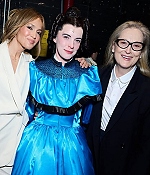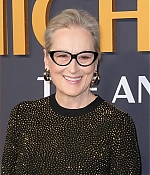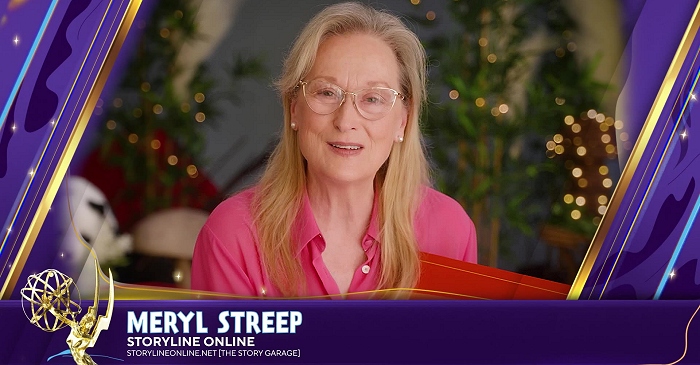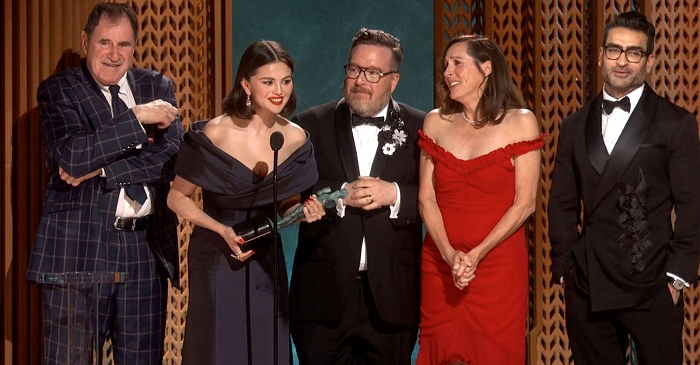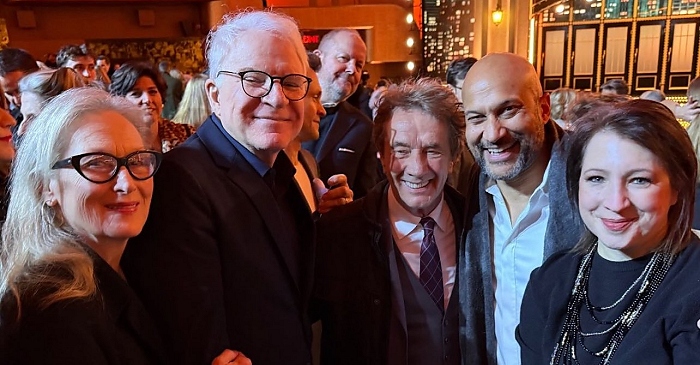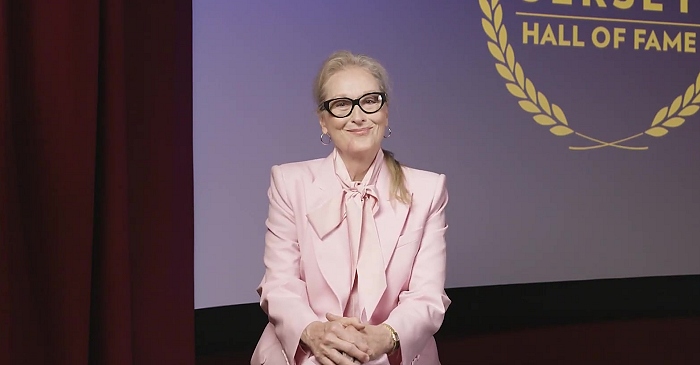|
Simply Streep is your premiere source on Meryl Streep's work on film, television and in the theatre - a career that has won her the praise to be one of the world's greatest working actresses. Created in 1999, we have built an extensive collection to discover Miss Streep's body of work through articles, photos and videos. Enjoy your stay.
|
Celebrating
25 years
of SimplyStreep
|
|
The Many Faces of Meryl Streep
The Philadelphia Inquirer ·
June 08, 1989
· Written by Carol Horner
|
How’s this? Envision Meryl Streep ugly and unpopular. Impossible, you say? But she says it was true in her childhood, in the ’50s in the suburbs of northern New Jersey. “I thought no one liked me,” she told a Time magazine reporter a decade ago. She described running from an irate crowd of youngsters and climbing a tree to escape them.
“Besides that,” Current Biography 1980 reports her as saying, “I was ugly. With my glasses and permanented hair, I looked like a mini-adult. I had the same face I have today and . . . the effect wasn’t cute or endearing.” Cute and endearing probably aren’t the words you’d choose for Streep’s face even today. Expressive, yes. Commanding, yes. Intelligent, yes. And beautiful, certainly. But a face you could die for isn’t what this acclaimed actress is all about. Not even close. She has won praise, as well as eight Academy Award nominations and two Oscars, for memorable portrayals of complicated women – a stunning variety of complicated women. In her first significant film role, in the 1978 movie The Deer Hunter, Streep played vulnerable Linda, home-town girlfriend of a steelworker-soldier. The role won her notice and her first Oscar nomination, as best supporting actress (she lost to Maggie Smith, who won for her role in California Suite).
The following year, she appeared in Manhattan as Woody Allen’s lesbian ex- wife and in The Seduction of Joe Tynan as a Southern civil rights lawyer who has an affair with a U.S. senator (played by Alan Alda). That same year, her portrayal in Kramer vs. Kramer of a woman who leaves her husband and son, returning to reclaim custody in a painful court proceeding, won Streep an Oscar as best supporting actress. Throughout the 1980s, the list of stunning Oscar-nominated performances has grown: the fallen Victorian heroine in The French Lieutenant’s Woman; the Polish Jew in Sophie’s Choice who is forced to choose which of her two children to save from execution by the Nazis; nuclear activist Karen Silkwood in Silkwood; African adventuress Karen Blixen in Out of Africa; the derelict Helen in Ironweed, and, most recently, an Australian woman wrongly accused of murdering her child in A Cry in the Dark, which is being released on video this week. (Streep won the Oscar for best actress for Sophie’s Choice.) It’s a dazzling array, and Streep relishes the mix. “It tickled me to be Baroness von Blixen in these $500 riding boots in Africa reading the script for Heartburn, about this woman who’s schlepping two suitcases, a baby and a stroller through the airport,” Streep told the Washington Post in 1986. “I completely understood that woman, as well as I felt I understood some parts of Karen Blixen.
“It’s heartening to me, it’s heartening to be embarked on this look at all these different women. That’s my secret pleasure in it.” Streep came to the “secret pleasure” of performing early. The girl who was born Mary Louise Streep on June 22, 1949, in Summit, N.J., made a splash with her soprano voice at age 12 singing “O Holy Night” in a school concert. (Her mother, a commercial artist, started calling her Meryl soon after birth. Her father was a pharmaceutical executive.) Fostering her talent with vocal lessons over the next four years, Streep was chosen for important roles in the musical comedies presented at Bernardsville High School. Meanwhile, she vowed to turn herself into “the perfect Seventeen magazine knockout,” she told Time magazine. She got rid of her glasses, put peroxide on her brown hair – and made the cheerleading squad and was elected homecoming queen.
At Vassar College, Streep continued to act. And she loved the free-thinking atmosphere on campus in the late ’60s, contrasting it in an interview with Ms. magazine with her “socially cutthroat, huge, co-educational high school.” “I remember feeling: ‘I can have a thought. . . . I can do anything, because everything is allowed.’ Oh, it was a great relief,” she said.
(Is there a hint here of the woman who would one day lend her famous name, and her voice, to the campaign against potentially harmful food pesticides? Streep, married to sculptor Don Gummer since 1978 and mother of three children, ages 9, 5 and 3, has recently appeared on behalf of the Natural Resources Defense Council, a nonprofit environmental organization.) After graduating from Vassar in 1971, Streep worked with a summer-stock company in Vermont, later attending the Yale Drama School. According to Current Biography 1980, she performed at least 40 roles in her three years there, turning herself into “something of a local legend.” Today the legend – if legends can be said to exist when an actress is in her prime – is about the woman whose performances are most often seen as evocative, provocative, enchanting and seductive – even if mannered, self- conscious and cold to certain critics.
Some have seen Streep’s compelling personal transformations on screen as something akin to mysterious. “She is one of the great enchantresses, a creature of mystery who haunts our dreams,” Robert Brustein, dean of the Yale School of Drama during Streep’s years there, said in a 1987 Life magazine article. Cher, who co-starred with Streep in Silkwood, is more practical in her assessment. She called Streep “an acting machine in the same sense that a shark is a killing machine. That’s what she was born to be.” In Life, writer Brad Darrach tells a Streep story that is the stuff of legends. It’s about how, in Ironweed, Streep, who had been hugging a bag of ice cubes to help imagine how it felt to be a corpse, lay “like an iced mackerel” through take after take of a scene in which Jack Nicholson, her equally derelict lover, sobbed over her dead body. Streep’s stillness scared at least one crew member, who whispered to director Hector Babenco, “What’s going on? She’s not breathing!” Babenco was startled to realize that there were no signs of life in Streep’s body, but he let the scene proceed. According to Darrach, it was not until 10 minutes after the scene was finished and the set struck that Streep slowly began to emerge from “the comalike state into which she has deliberately sunk.” “Now that is acting! That is an actress!” Babenco is quoted as saying. A clue to how she does it may be found in Streep’s own words:
“Helen has none of the things most people covet – possessions and accomplishments and children. All she has are the purest impulses – fidelity and pride and resilience. I liked playing a stripped-down character. Even her age was a mystery. I located one for purposes of reality, but then I threw it away. People who live on the edge don’t know how old they are. . . . So Helen is sort of an ember in this. We just get the last glow, and then she goes.” Streep expects to experience her characters deeply. “It’s the great gift of human beings that we have this power of empathy,” she told Life. “We can all sense a mysterious connection to each other. And that’s good. If there’s hope for the future of us all, it lies in that. “And it happens that actors can evoke that event between hearts. And when they do – well, if I’m in the audience, it makes me feel bigger. Enhanced. Even by the most tragic thing. I’m drawn out of my own life into someone else’s life, and yet suddenly I myself feel more alive! I’m pulled out of what I do every day into something larger and more lasting – into humanity. That’s what an actor can do. That’s what I want to do.”

